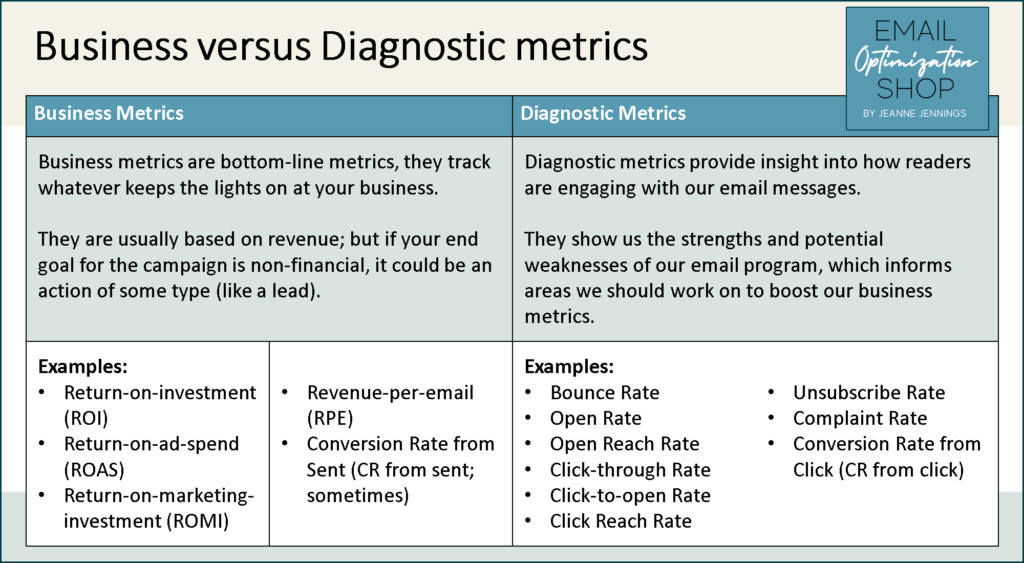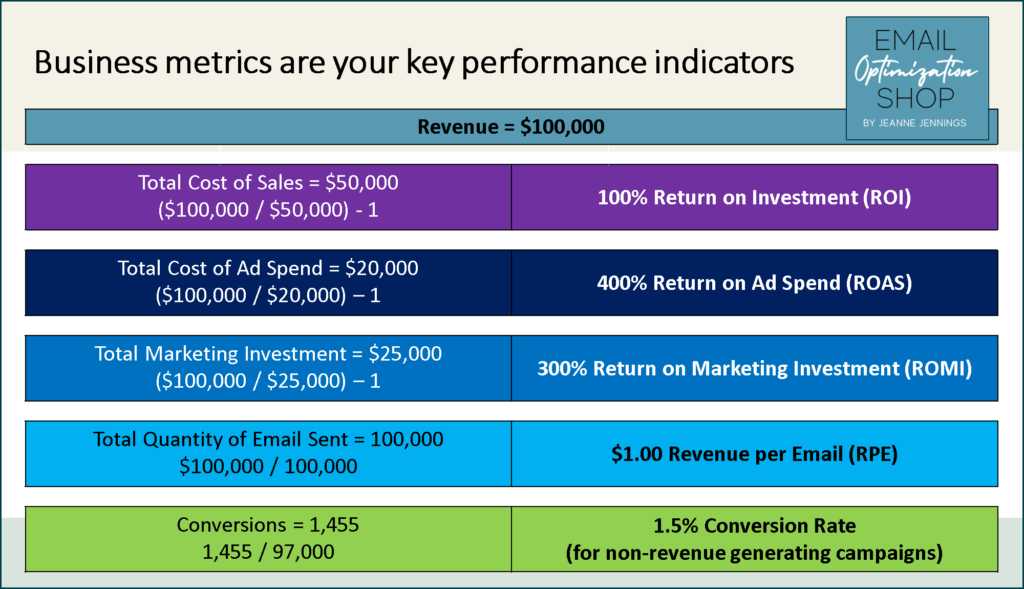I am not only an email geek, I’m an email metrics geek! But not all email metrics are created equal.
Open and click-through rates (CTR) are nice; but return-on-ad-spend (ROAS) and revenue-per-email-sent (RPE) are better.
Here’s why.
Open rate and CTR are diagnostic metrics; they tell us how recipients engaged with our email messages.
But ROAS and RPE are business metrics; they speak to us about the bottom-line success or failure of a campaign. They speak to revenue, not just open or clicks.
Most of the businesses I know run on revenue, not opens or clicks. They need revenue to pay the utility and other bills. Which is why, while it’s good to know what your open rates and CTRs are, it’s critical to know what your ROAS, RPE, or other business metrics are.
You should always use a business metric as your key performance indicator (KPI); a KPI is what you use to determine how successful a campaign was. A table about the differences between diagnostic and business metrics appears below. .

Below is a slide showing the calculations for common business metrics.

Many email marketers know a lot about diagnostic metrics, but less about business metrics. Here are answers to some common questions about business metrics.
What if the end goal for your email campaign isn’t a sale? What if it doesn’t involve revenue?
The most common example of this is a lead generation email campaign. These are usually used for sales which require customized pricing, like some consulting services, or for high-dollar purchases where a salesperson is involved in closing the sale.
In this case, your initial key performance indicator for the campaign would be conversion rate from sent (CR from sent). The ‘conversion’ would be a lead being generated (usually this involves the email recipient filling out an online form).
Other non-revenue goals where you would use conversion rate as your KPI:
- Download of a white paper, special report, app, or other item
- Sign-up for a free trial
- Request information, or that a sales representative contact them
- Watch a video
- View a certain number of pages after clicking through from the email to a website (sometimes used when the revenue model is ad-based and relies on impressions)
- Opt-in for email (if the mailing goes to a list that’s not your own)
- .Any other non-revenue action that is the immediate end-point for the email interaction
Why not just always use Return-on-Investment (ROI) as your KPI? Why do we need other business metrics?
True ROI is difficult to calculate. You need to include all the costs associated with the sale, including the costs of production, shipping, salaries, overhead – you get the idea. It’s a lot of work and while companies do this at an aggregate level to report on earnings, it’s not something that’s done on the granular level for a single campaign.
Return-on-ad-spend (ROAS) and/or Return-on-marketing-investment (ROMI) are similar to ROI but easier to calculate. The ad spend or marketing investment are coming from the marketing budget, so the email marketing team should have easy access.
Revenue-per-email-sent (RPE) is the very easiest revenue-related metric to calculate. All it requires is the revenue generated and the number of email messages sent (this can also be thought of as the number of unique recipients). While it doesn’t include costs like ROAS or ROMI, it can be used to gauge the success of one campaign over another, assuming the products being sold are roughly the same price.
Will my email platform automatically calculate the business metrics for me, as it does the diagnostic metrics?
It depends. Most email platforms are capable of pulling the revenue and/or number of orders generated from an email campaign into its dashboard and then calculating RPE and/or CR from sent. But this usually requires some work on your end (or your IT department’s end).
In some cases the email platform provides you code to put on the confirmation page of your site – it tracks and matches any revenue or orders generated back to the email that drove the buyer to the site. Another way to track revenue and orders is to use Google analytics and UTM codes; this requires an integration to get the data back to your email platform.
Closing Thoughts
Getting smarter about business metrics, and knowing which KPI to use based on your goals, is one way to improve your email marketing expertise – and your performance. Give this a try with your email marketing program and let me know how it goes!
jj

I never took into account the fact that the business metric must always be used to ensure that your key performance indicator would be able to tell the success of the campaign. In my opinion, there is so much technicality in this kind of field, so professionals in diagnostics consultant services should be utilized when you have a medical facility or any kind of business. I think the main goal of most facilities or companies profit or income for them and their employees, so investing in something that will get them more customers or patients would be worth it.
Yes! Too many people are using diagnostic metrics as KPIs, and too often this causes them to leave money on the table and not truly optimize their programs.